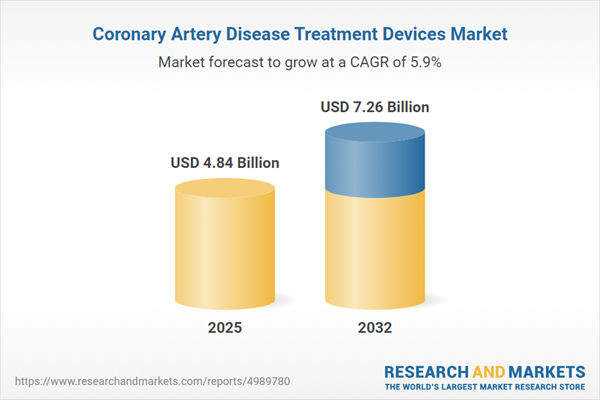Speak directly to the analyst to clarify any post sales queries you may have.
The coronary artery disease treatment devices market is rapidly evolving, shaped by device innovation and deeper clinical insights. Senior healthcare stakeholders face complex choices as advancements redefine intervention strategies and influence healthcare delivery worldwide.
Market Snapshot: Coronary Artery Disease Treatment Devices
The coronary artery disease treatment devices market grew from USD 4.58 billion in 2024 to USD 4.84 billion in 2025. It is expected to continue advancing at a CAGR of 5.92%, with projected revenues reaching USD 7.26 billion by 2032. Growth is fueled by the rising prevalence of coronary artery disease and ongoing progress in device-based therapies. Forward-looking organizations are focusing on device integration, improved procedural outcomes, and adaptive regulatory frameworks to remain competitive in a dynamic landscape.
Scope & Segmentation
- Device Types: Atherectomy devices (laser, orbital, rotational), balloon catheters (cutting, drug-coated, standard), guidewires (polymer-jacketed, PTFE-coated, untreated), intravascular imaging systems (fractional flow reserve, intravascular ultrasound, optical coherence tomography), and stents (bare metal, bioresorbable scaffold, drug eluting)
- Treatment Modalities: Coronary artery bypass grafting (off-pump, on-pump), and percutaneous coronary intervention (with balloon angioplasty, with stenting)
- Approaches: Transfemoral, transradial
- End Users: Ambulatory surgical centers, cardiac centers, hospitals
- Regional Coverage: Americas (North America, Latin America), Europe, Middle East & Africa, Asia-Pacific (China, India, Japan, Australia, among others)
- Key Players: Abbott Laboratories, Boston Scientific Corporation, Medtronic plc, Terumo Corporation, Biotronik SE & Co. KG, Lepu Medical Technology, Meril Life Sciences, OrbusNeich Medical, MicroPort Scientific, Cardinal Health
Key Takeaways for Senior Decision-Makers
- Technological advances drive the integration of high-resolution imaging, personalized stenting, and enhanced atherectomy systems, delivering greater clinical precision and procedural efficiency.
- Expanded segmentation analysis highlights that access approaches and end user settings significantly impact device adoption, procedural outcomes, and resource allocation for providers.
- Regional variability in infrastructure, reimbursement pathways, and training programs shapes the market environment; tailored strategies remain essential for success across geographies.
- Competitive activity is fueled by robust R&D investments, mergers and acquisitions, and strategic partnerships which accelerate clinical validation and broaden technology portfolios.
- Real-world evidence and post-market surveillance have risen in importance, equipping stakeholders to optimize clinical protocols and respond to evolving patient needs with greater agility.
- Manufacturing innovations, including additive technologies and digital quality controls, are improving consistency and expediency across global supply chains.
Tariff Impact on Supply Chains and Cost Structures
Recent updates in import tariffs on coronary treatment devices are reshaping global supply chains for manufacturers and providers. Tariff-driven cost pressures prompt healthcare organizations to review procurement strategies, develop regional partnerships, and seek efficiencies in local assembly. These changes emphasize the need for robust inventory management and collaborative approaches to ensure reliable access to devices, particularly in resource-intensive environments.
Report Methodology & Data Sources
Findings in this report are built upon a mixed-methods research approach. Sources include comprehensive literature reviews, regulatory documents, and in-depth interviews with clinicians, procurement experts, and industry executives. Structured surveys and triangulated validation ensure both accuracy and practical relevance for market stakeholders.
Why This Report Matters
- Delivers actionable intelligence for optimizing investment, R&D prioritization, and operational planning in the coronary artery disease treatment devices market.
- Provides guidance on adapting to regulatory shifts, emerging technologies, and complex segmentation trends across device portfolios and care settings.
- Supports supply chain resilience and strategic partnership development, empowering organizations to navigate rapidly shifting market conditions with confidence.
Conclusion
This report equips senior leaders with the essential knowledge and strategic direction to enhance competitiveness and drive effective innovation in the coronary artery disease treatment devices market. Informed decision-making will enable stakeholders to improve clinical outcomes while effectively managing evolving infrastructure, tariff, and procurement challenges.
Additional Product Information:
- Purchase of this report includes 1 year online access with quarterly updates.
- This report can be updated on request. Please contact our Customer Experience team using the Ask a Question widget on our website.
Table of Contents
3. Executive Summary
4. Market Overview
7. Cumulative Impact of Artificial Intelligence 2025
Companies Mentioned
The companies profiled in this Coronary Artery Disease Treatment Devices market report include:- Abbott Laboratories
- Boston Scientific Corporation
- Medtronic plc
- Terumo Corporation
- Biotronik SE & Co. KG
- Lepu Medical Technology (Beijing) Co., Ltd.
- Meril Life Sciences Pvt. Ltd.
- OrbusNeich Medical Company Limited
- MicroPort Scientific Corporation
- Cardinal Health, Inc.
Table Information
| Report Attribute | Details |
|---|---|
| No. of Pages | 193 |
| Published | November 2025 |
| Forecast Period | 2025 - 2032 |
| Estimated Market Value ( USD | $ 4.84 Billion |
| Forecasted Market Value ( USD | $ 7.26 Billion |
| Compound Annual Growth Rate | 5.9% |
| Regions Covered | Global |
| No. of Companies Mentioned | 11 |









